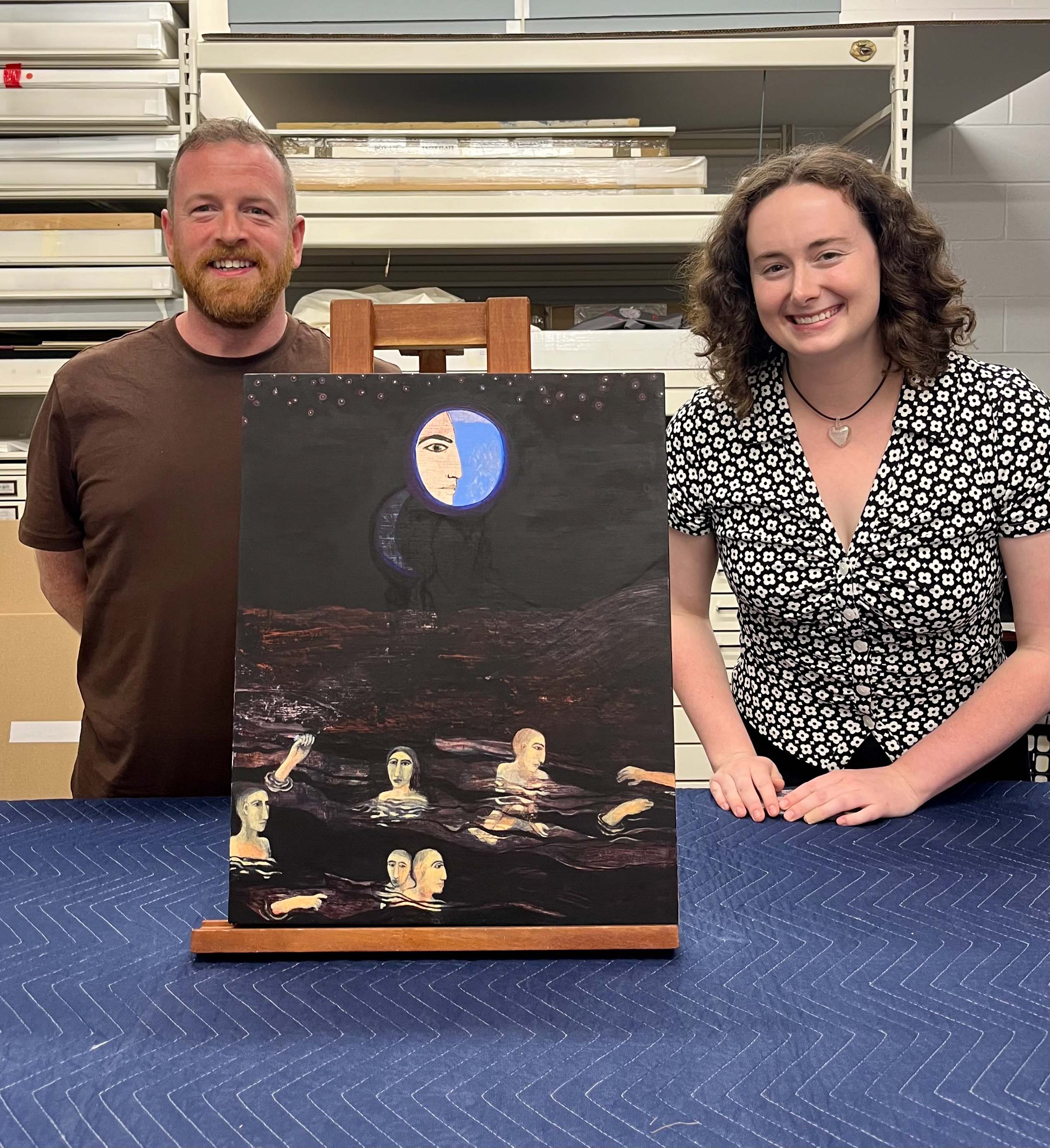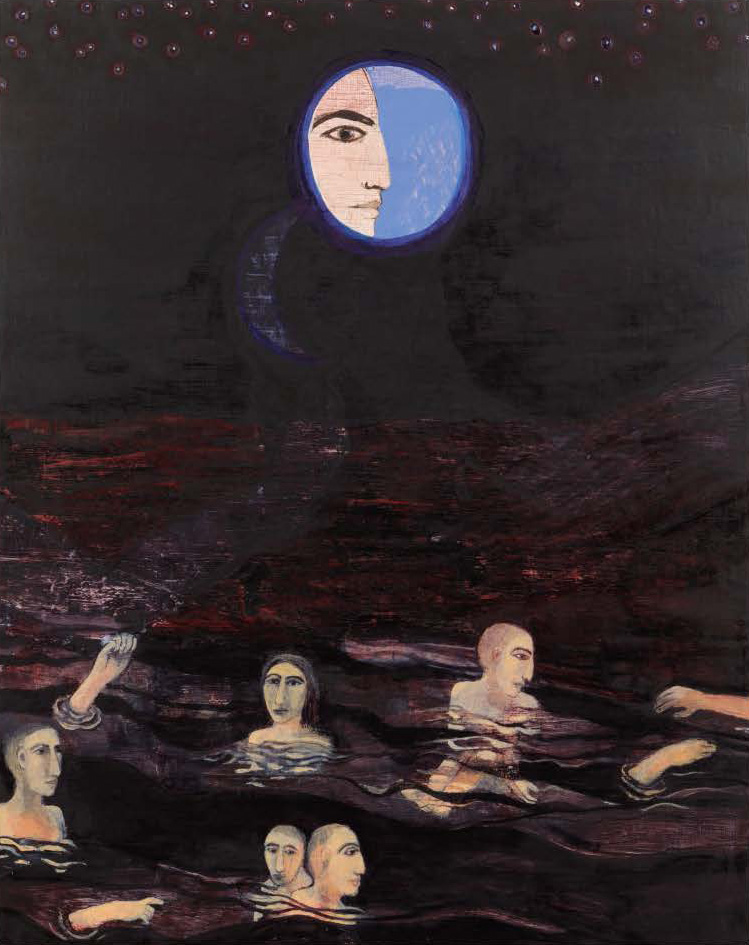Object of the Month: 'Second Moon #2' by Samira Abbassy
By Bowdoin College Museum of Art
Sean Kramer (pictured left), Andrew W. Mellon Postdoctoral Curatorial Fellow, and Emily Jacobs '23 (pictured right), Curatorial Assistant and Manager of Student Programs, with Second Moon #2 by Samira Abbassy
In an exciting collaboration between Bowdoin College students and the Bowdoin College Museum of Art (BCMA), Samira Abbassy’s painting Second Moon #2 has joined the BCMA’s Permanent Collection. This acquisition marks a milestone in the BCMA’s newly launched Student Acquisition Program, an initiative which gives students the opportunity to select and acquire art for the Museum’s collection.
The Student Acquisition program was spearheaded by Emily Jacobs ’23, former student intern for campus engagement, with BCMA curatorial staff member Sean Kramer, Andrew W. Mellon Postdoctoral Curatorial Fellow. The inaugural run of the project brought together a dedicated group of students from the 2023–2024 Bowdoin Art Society, including Andrew Tran '26, Sabrina Kearney '26, Julia Xiang-Wang '26, Neiman Mocombe '26, Christ'Ella Francis '26, Lauren Russler '26, Lauren Bains '27, Bridget Love '27, Rebekah Jaksa '27, Anna Chen '26, and Patrick F. Sullivan '26. Together, the group developed a twofold goal of acquiring an artwork that expands the breadth of the Permanent Collection and that speaks to Bowdoin students’ experiences and perspectives. The students worked to identify and research potential artworks, ultimately selecting Second Moon #2 for presentation to the BCMA’s curatorial team. The acquisition offered students valuable insight into museum practice and the process of bringing an important work of art into the collection.
The work of Samira Abbassy captivated students’ discussions during the initial research phase. Abbassy was born in 1965 in Iran before moving to the United Kingdom as a child. She then moved to the United States in 1998, where she now lives and works. She is renowned for her work in painting, drawing, and sculpture, which often explores the intersections of personal identity, cultural heritage, and broader sociopolitical issues. Abbassy’s Second Moon #2 is a striking example of her ability to weave together personal and collective narratives. The painting features fluid, rippling lines that suggest both water and strands of hair, with androgynous figures floating through the composition. These elements evoke themes of transformation, gender fluidity, and cultural identity, resonating deeply with both Abbassy’s own experiences as an artist in the Iranian diaspora and with contemporary global issues.
Abbassy’s layered symbolism and the plurality of interpretations in Second Moon #2 made this work a standout, with each student finding a new reading or a new dimension in the painting. For some, the connection to Iranian histories was the most compelling. Abbassy draws on the Persian style of Qajar portraiture from the nineteenth century, especially in her treatment of figures. In both this historical style and Abbassy’s contemporary work, figures exhibit a fluid and more androgynous gender presentation. Calling to this historical mode of representation, Abbassy interrogates present-day issues of gender in Iran and around the globe. The symbolism of hair was another significant touchpoint for students, with the water flowing like hair across the canvas and with many figures exhibiting bald heads. Given the politicization of hair in Iran, students were eager to read Abbassy’s painting as a story of resistance. In 2022, Mahsa Amini fell into a coma and died after being released by the Iranian Guidance Patrol (also known as the morality police). She was initially detained for incorrectly wearing the hijab, and this incident of state brutality sparked a movement of protests around the globe. These actions saw women shaving their heads in defiance of Iran’s veiling order, and students hypothesized that Abbassy’s exploration of hair and her figures’ shaved heads served as a memorialization for Amini and the collective action her death inspired.
For other students, seeing the figures crossing the waters conjured up religious and mythological themes, as well as contemporary stories of migration. Others still were most interested in the lunar imagery in the painting, which served as another call to Iranian history and cultural tradition while also reflecting on the phases of the moon as a natural cycle of change and transformation.
Second Moon #2 will be included in the upcoming exhibition Irreplaceable You: Personhood and Dignity in Art, 1980s to Now, opening in January 2025. The painting will serve as an important object for interdisciplinary study at Bowdoin, offering valuable insights into topics such as identity, displacement, cultural fluidity, and the intersections of art and activism. It will also serve as a resource for students and faculty across various academic disciplines, including Art History, Middle Eastern and North African Studies, Gender, Sexuality, and Women’s Studies, and more.
As part of the BCMA’s Permanent Collection, Second Moon #2 will continue to inspire and engage the Bowdoin community for generations to come, serving as a testament to the power of student involvement in shaping the future of art and cultural heritage.

Samira Abbassy, Second Moon #2, 2022, oil on birch panel, 50.8 x 40.6 cm (20 x 16 in.). Bowdoin College Museum of Art, Brunswick, Maine, Barbara Cooney Porter Fund. Courtesy of the artist and Elizabeth Moss Galleries.